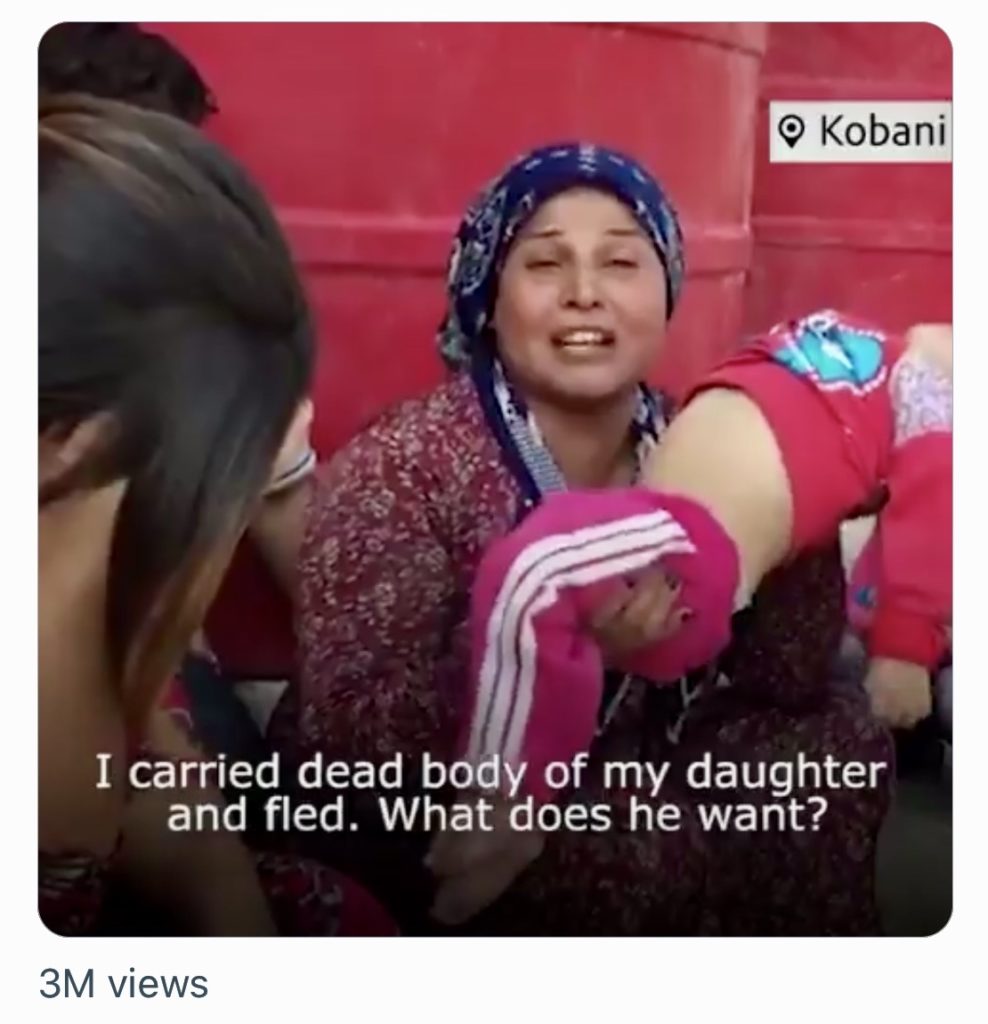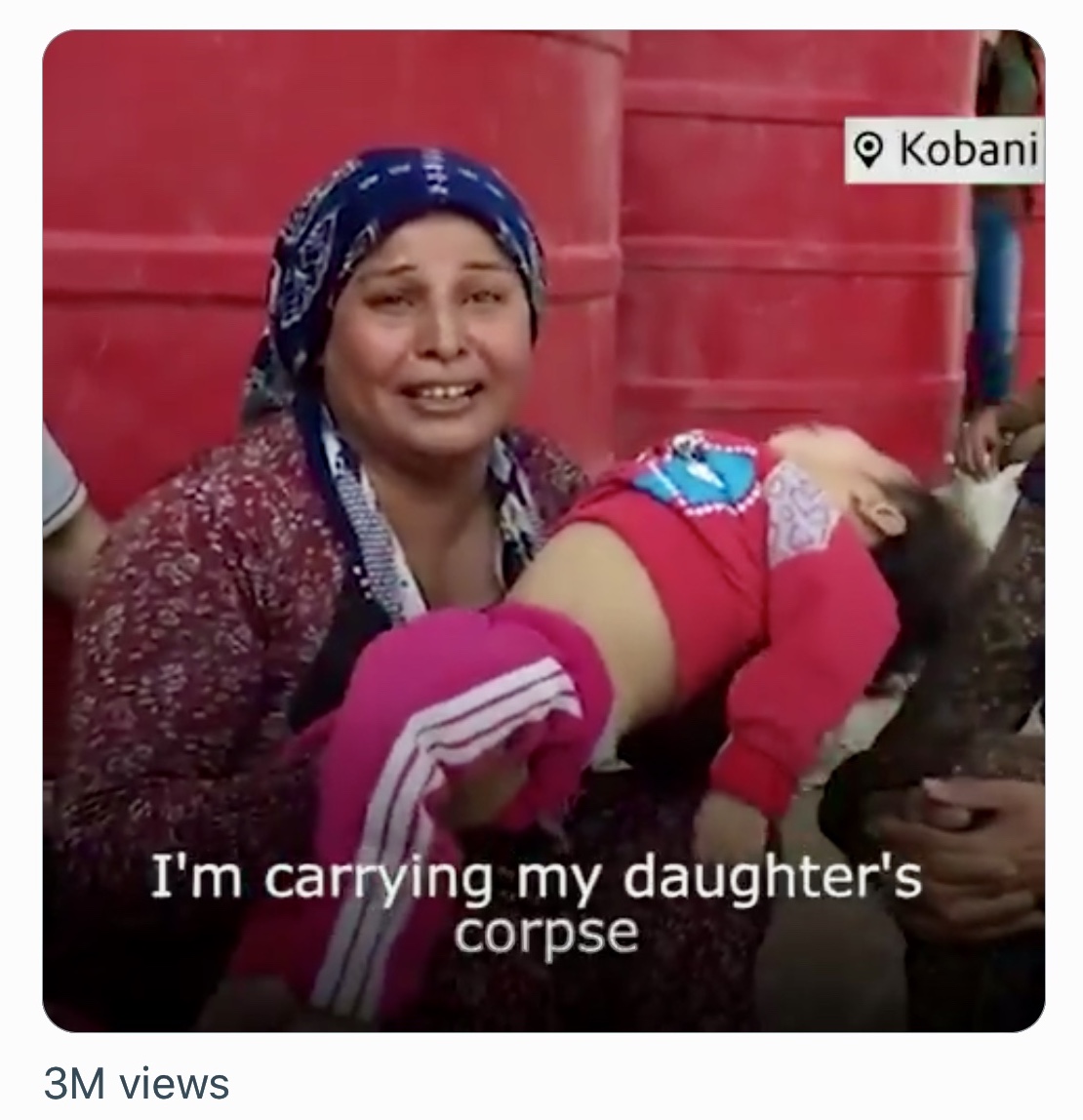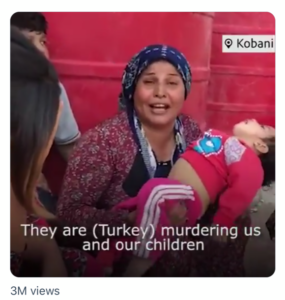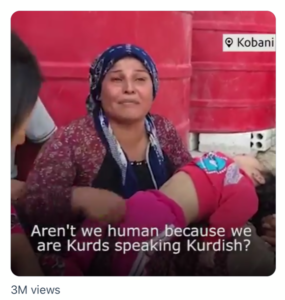BBG – USAGM Watch Commentary
Experts critical of Russia’s Vladimir Putin and Turkey’s Recep Tayyib Erdoğan have raised alarm that a few days ago a German journalist was attacking “activist” journalists, accusing them of spreading online fake news in a video relating to Turkish military actions against the Kurds. The experts who are sympathetic toward the Kurds assumed at first that the accusations coming from the German journalist were false and were part of Turkey’s disinformation efforts. The charges of irresponsible journalism centered around a highly emotional video showing a Kurdish woman holding what looked like a dead body of a young girl. English captions of what the mother was saying presented the girl as her dead daughter. According to the same captions, the mother blamed Turkey for her death. It later came to light that the Voice of America (VOA) reporter who, according to his Twitter page, works for one of VOA’s foreign language services, re-tweeted the video with his own short introduction expressing his horror and without questioning the central claim of the video that the young Kurdish girl was dead. His Twitter account has a link to the VOA News website. VOA Director Amanda Bennett is listed as one of his Twitter followers.
The girl, however, was not dead, as many people who viewed the entire video have pointed out in multiple comments under the VOA journalist’s tweet. The video, as seen Tuesday (October 15, 2019) on the Twitter feed of the VOA reporter, already had over three million Twitter views thanks to multiple re-tweets such as his.
Criticism of journalists who used the video with the false claim turned out to be valid in this case, although it is not clear that the Voice of America journalist intentionally re-tweeted the questionable video in full knowledge that some of the critical information contained in it was in fact false. However, by failing to exercise caution and due diligence in checking out of all information being presented in the video he retweeted, the VOA reporter provided ammunition to critics against himself, against the Voice of America, against the U.S. government, and ultimately against the Kurds. False journalistic claims do not advance the cause of human rights, they harm the victims of human rights violations by undermining general trust in journalism. Even after it became obvious to the VOA reporter sometime later from many comments on his Twitter feed that the girl was not dead, he did not apologize or delete his tweet. He tweeted other links to the video, some of which also had false information about the girl. As of the morning of October 16, these tweets remain on his Twitter account.

Some of the tweets by the VOA reporter (there were other tweets which appeared questionable) can be seen also as a sad commentary on the mismanaged state of the Voice of America and its parent federal agency, the U.S. Agency for Global Media (USAGM) which was previously called the Broadcasting Board of Governors (BBG). The ultimate blame for what has been described by some critics as a dangerous slide toward irresponsible journalism in the last four years falls on leaders in charge of USAGM and VOA who came to the agency during the previous administration.
The journalistic mistake in this case was of a highly serious nature due to the very sensitive issues at stake and a great potential for damage to America’s reputation and to any justified grievances that the Kurds most definitely have against the Turkish government. It is bad enough that the withdrawal of U.S. troops from Syria ordered by President Trump has become a public diplomacy disaster for his administration and for the United States. Many, including quite a few Republicans, question his decision, how it was arrived at, and how it was announced. It’s a highly emotional issue with possible volatile consequences for the region and for the United States. But regardless of what assessments people have made about President Trump, the fallout from his decision requires a responsible, fact-based, scandal-free reporting, at least by U.S. government journalists being paid by U.S. taxpayers. It also requires a careful handling by U.S. public diplomacy specialists.
Private commentators and reporters who may or may not be biased or partisan but who do not draw government salaries can, of course, say or write what they want, subject only to any scrutiny by their private employers and their audience. VOA journalists are, however, in a different category than the private sector media. They are public servants accountable to all Americans. They are America’s voice abroad and increasingly in the United States because what they write and post on social media and VOA’s official web sites can be seen by at least some American voters and conceivably can influence outcomes of American elections. Their journalism, whether they like it or not or want to admit it, is regulated by U.S. law, i.e. the 1976 VOA Charter. The law says that VOA reporting must be accurate and must be properly balanced.
When it comes to truthful and responsible journalism, no cause or grievance, however just, should have an impact on the absolute necessity for the Voice of America to report nothing but verified facts, to tell nothing but the truth. During the Cold War, VOA journalists were extremely careful not to fall for any kind of false propaganda, including disinformation from unknown or suspicious sources which on the surface may have appeared to be directed against the communist regimes but was too good to be true. They knew that false information could destroy VOA’s credibility in an instant, and therefore their effectiveness as journalists. VOA’s senior and mid-level management at that time would have never tolerated major journalistic lapses that are now plaguing the organization almost every day.
It’s not just “fake” or false news but also lack of balance, lack of proportion and in some cases extreme partisanship that has made the Voice of America increasingly misleading.
Support for the so-called Captive Nations of Eastern Europe was much greater during the Cold War than American support for the Kurds now, but former VOA journalists would never report, as we have seen in some recent tweets by a VOA reporter, that large numbers of Americans were protesting in front of the White House. Such reporting would have been misleading and might have created false assumptions and hopes. A few years ago, a reporter from a different VOA foreign language service posted a photograph of herself protesting in front of the White House draped in the flag of her native country.
Such reporting and behavior by VOA journalists would not have been tolerated during the Cold War. As things stand now, large numbers of Americans don’t know about the Kurds, but many Americans are now getting misleading information from VOA on social media. Many of these tweets, some of them in English as in the case of the Kurdish video, could also have an impact on U.S. politics and U.S. elections.
The subtitles in the video retweeted by the VOA reporter with his brief introduction recommending the report say that the little girl is dead. Many people who saw this tweet immediately commented under the VOA reporter’s post that the girl in the video was turning her head, blinking her eyes and was obviously not dead despite of what the subtitles said. Some suggested that she may have been sick. Others showed by their comments that they accepted the video’s claim and became convinced that the girl was dead. They usually showed in their comments that they blamed President Trump for her death. It appears from Twitter time stamps that the VOA reporter sometime later added his own comment that the girl was not dead. However, he did not immediately delete his highly emotional and misleading tweet. He did not question the content of the video when he first posted it for others to see and gave it his stamp of approval as a Voice of America journalist.
The good news is that some ordinary Americans and many news consumers abroad are far better in spotting false information than some VOA reporters, but disinformation still spreads on social media like a fire storm. At least one former U.S. diplomat also fell for the dead girl narrative, although in response to a different version of the video without the English subtitles. Ambassador Susan Rice, former U.S. National Security Advisor to President Obama and his former U.S. Ambassador to the United Nations tweeted: “WTF?? This blood is on Trump’s hands alone but the shame is shared by all decent Americans.”
In addition to the video with English subtitles, the VOA reporter also re-tweeted video used by Ambassador Rice. Her tweet had the following intro to the video. It was written by the person whose tweets were being re-tweeted by the VOA reporter and others: “I left my husband behind us in Kobani. I thought I could save our daughter away from bombing, but unfortunately she died on the road. Where is the free world.. Where are those who talk about humanity, Who talk about values.. what does Ardogan [Erdogan] want from us?”
WTF?? This blood is on Trump’s hands alone but the shame is shared by all decent Americans. https://t.co/w3b3t5ncjN
— Susan Rice (@AmbassadorRice) October 13, 2019
The post retweeted by Ambassador Rice was also retweeted by the VOA reporter, including the claim that the girl “died on the road.”
Ambassador Rice is not a journalist. The bad news is that some VOA reporters repeatedly post tweets with false information without checking it first. They do not follow the two-source rule, especially not on Twitter and Facebook, but also in quite a few reports posted on the main VOA news websites. This is almost entirely the fault of the USAGM and VOA management. The agency’s leadership has proven itself incapable of providing proper guidance and oversight. The fear is that sooner or later this will lead to a major international incident, in which people may die, or a major domestic scandal. Former USAGM CEO John Lansing (he is now in charge of NPR) and VOA Director Amanda Bennett were warned about these problems many times before, for the first time in 2016. Nothing much has changed. Many scandals of various nature have been reported at the agency in the past several years.
These are not isolated cases of sloppy reporting. One senior VOA English Newsroom reporter who promptly posted what turned out to be later fake information from an ABC News journalist even vouched on Twitter for the ABC reporters’ solid credentials in investigative journalism. The ABC reporter was suspended after his news was declared false. The VOA reporter, however, continued to receive high praise from VOA executives and even briefly banned from seeing his VOA Twitter account some American journalists who had questioned his habit of posting tweets with unverified information from a single source. Just a few days ago a VOA reporter had to disavow another one of his tweets. He did it on his own. It is doubtful that his managers even noticed.
The public diplomacy damage for the U.S. over the Syria decision is big enough on its own and it is being reported. VOA does not need to put out fake information to make it worse and more explosive for the innocent people in the region and for the United States. The situation of the Kurds, in Syria and elsewhere, is volatile as it is. They have seen a lot of suffering and their human rights need to be protected. Their plight should not be made more volatile by the failure of Voice of America executives to lead and manage the U.S. taxpayer-funded organization. We don’t blame individual VOA reporters as much as we blame the USAGM and VOA leadership. This is a problem created by the current management and its unwillingness or inability to manage.




